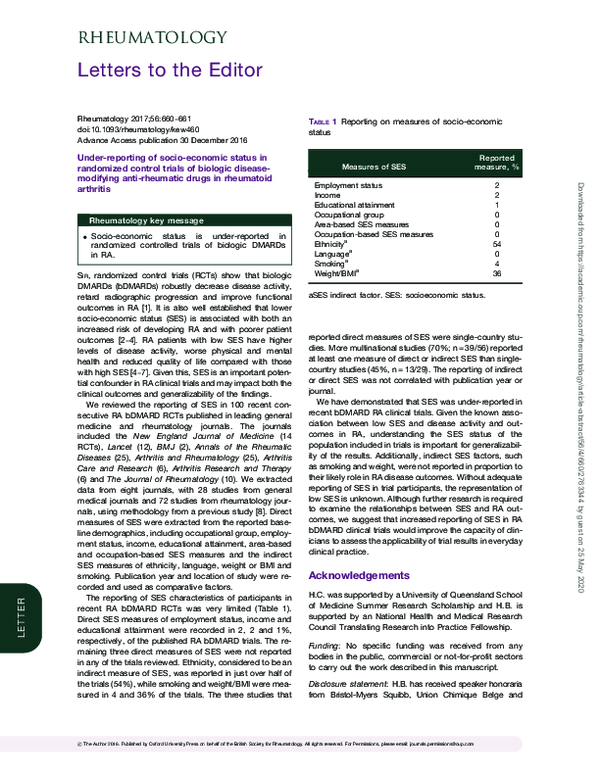Academia.edu no longer supports Internet Explorer.
To browse Academia.edu and the wider internet faster and more securely, please take a few seconds to upgrade your browser.
Under-reporting of socio-economic status in randomized control trials of biologic disease-modifying anti-rheumatic drugs in rheumatoid arthritis
Under-reporting of socio-economic status in randomized control trials of biologic disease-modifying anti-rheumatic drugs in rheumatoid arthritis
2016, Rheumatology (Oxford, England)
Related Papers
Arthritis Care & Research
Racial/ethnic differences in the use of biologic disease-modifying antirheumatic drugs among California Medicaid rheumatoid arthritis patients2013 •
Modern Rheumatology
Socioeconomic impact of treatment with biological disease–modifying antirheumatic drugs in Japanese patients with rheumatoid arthritisObjectives We evaluate the socioeconomic impact of treatment with biological and targeted synthetic disease–modifying antirheumatic drugs in Japanese patients with rheumatoid arthritis. Methods We analysed data retrospectively from the prospective observational CorEvitas RA Japan Registry (March 2016–February 2020). Patients were categorised into paid workers (PWs) and home workers (HWs) and further based on drug classes. We assessed medication persistence, treatment outcomes, health care resource utilisation, and socioeconomic impact over 12 months, including direct (drugs and health care resource utilisation) and indirect (loss of productivity) costs. Results Overall, 187 PWs and 114 HWs were identified. Over 12 months, medication persistence was high, treatment outcomes improved, and outpatient visits reduced in both groups. Following treatment initiation, direct costs increased, whereas indirect (loss of productivity) costs decreased in both groups. The unadjusted socioeconomic ...
Arthritis & Rheumatism
Impact of socioeconomic status on the course of rheumatoid arthritis and on related use of health care services2003 •
Social Science & Medicine
Disease activity and severity in patients with rheumatoid arthritis: relations to socioeconomic inequality1999 •
Annals of the Rheumatic Diseases
Socioeconomic deprivation and rheumatoid disease: What lessons for the health service?2000 •
The Journal of rheumatology
Does socioeconomic status affect outcomes in early inflammatory arthritis? Data from a canadian multisite suspected rheumatoid arthritis inception cohort2015 •
To assess the effect of socioeconomic status (SES) on outcomes in patients with early inflammatory arthritis, using data from the Canadian Early Arthritis Cohort (CATCH) study. In an incident cohort, 2023 patients were recruited, and allocated to low SES or high SES groups based on education and income. Outcomes at baseline and 12 months were analyzed in relation to SES including the 28-joint Disease Activity Score (DAS28), Simplified Disease Activity Index (SDAI), pain, patient's global assessment scale (PtGA), the Health Assessment Questionnaire-Disability Index (HAQ-DI), and the SF12-v2 Health Survey, using the ANOVA, chi-squared test, and regression analyses. The CATCH population had 43% with high school education or less and 37% in the low-income group (< 50,000 Can$ per annum household income). The low-education group had higher DAS28 at baseline (p = 0.045), becoming nonsignificant at 12 months and lower physical component score on SF12-v2 at baseline (p = 0.022). Pati...
Arthritis Research & Therapy
Treatment of rheumatoid arthritis in the Medicare Current Beneficiary Survey2013 •
Advances in Rheumatology
Real - rheumatoid arthritis in real life - study cohort: a sociodemographic profile of rheumatoid arthritis in BrazilBackground In Brazil, socioeconomic differences in the incidence of rheumatoid arthritis (RA) have been demonstrated, which are important in the formulation of hypotheses regarding the association between environmental factors, lifestyle and the risk of disease development. This study examines how the socioeconomic condition of the patient with RA in Brazil, assessed according to social class, educational level, employment situation and use of caregivers, affects the times between the beginning of symptoms and diagnosis and the beginning of the use of disease-modifying antirheumatic drugs, as well as the presence of erosive disease and functional status. Methods This work is part of a multicentric study called REAL - Rheumatoid Arthritis in Real Life in Brazil, which is a prospective observational cohort study. Results As described in the REAL study, we included a total of 1115 patients. It was noted that patients with an educational classification of up to second grade incomplete p...
RELATED PAPERS
Güvenliği Yeniden Okumak, ed. Harun Arıkan ve Ali Gök, Yetkin Yayınları, İstanbul, 2024
Soğuk Savaş Sonrası Dönemdeki Uluslararası Güvenliğin Dönüşümü Dinamiklerinde Ortaçağlaşma İzleri: Vestfalya Öncesi Düzen ile Karşılaştırmalı Bir Analiz2023 •
International Journal of Productivity and Quality Management
The development and research tradition of statistical quality control2010 •
IMAGÓTIPOS FEMININOS NAS LITERATURAS EM PORTUGUÊS A ORIENTE
MACAU E O OUTRO NA LITERATURA PARA A INFÂNCIA PORTUGUESA: O CASO DE ALICE VIEIRA E DE ONDINA BRAGA2024 •
1994 •
2020 •
Biophysical Journal
Molecular Basis Of Protein Localization To The Junctional Sarcoplasmic Reticulum Of Skeletal Muscle Cells2009 •
Environmental Science & Technology
Effect of solids concentration on the sorptive partitioning of hydrophobic pollutants in aquatic systems1983 •
Journal of Health Psychology
Attributions, distress and behavioural responses in the significant others of people with chronic fatigue syndrome2012 •
Journal of Political Economy
Water for Life: The Impact of the Privatization of Water Services on Child Mortality2005 •
Research, Society and Development
Influência da violência perpetrada por parceiro íntimo na prática do aleitamento materno2022 •

 Mieke van Driel
Mieke van Driel